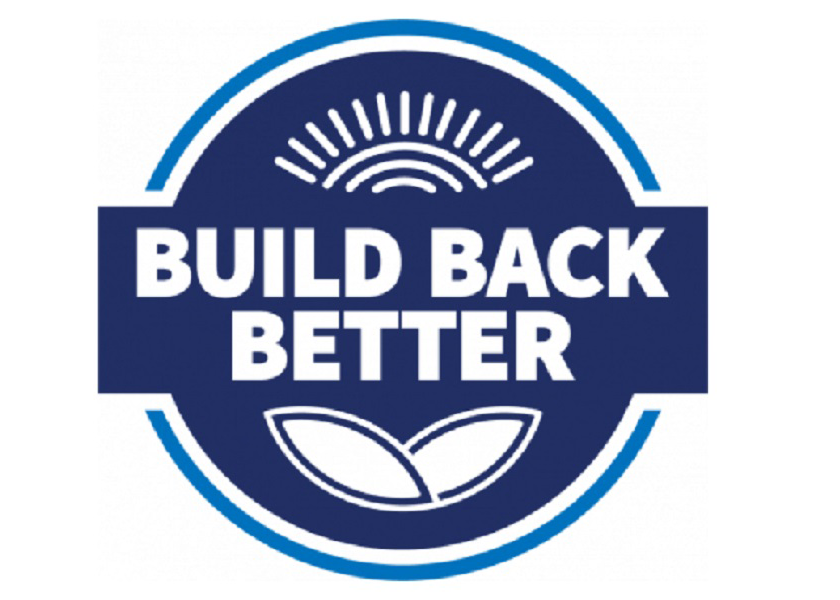$1B to Biofuels in Build Back Better

USDA Secretary Tom Vilsack and Rep. Cindy Axne joined AgriTalk with host Chip Flory and Pro Farmer policy analyst Jim Wiesemeyer recently to comb through President Biden’s reframe of the Build Back Better (BBB) plan.
The proposal is now $1.75-trillion dollars and is almost 25-hundred pages long. It includes the following for biofuels:
$1 billion in funding for the biofuels industry
A four-year extension of the $1dollar biodiesel tax credit
Plans to develop "sustainable aviation fuels
$320 billion in clean energy tax credits
$110 billion for investments in clean energy technology
$105 billion to address extreme weather
Ethanol
“There is a specific appropriation of $1 billion for the industry,” says Vilsack. “Secondly, there are a series of tax credits the industry could potentially take advantage of as it formulates low carbon fuel, and the combination of those two is a very positive aspect.”
Projections for sustainable aviation fuel (SAF) have been top-of-mind for Vilsack. He says the industry can expect a 35-billion-gallon demand.
Opportunities for production facilities to “be able to store carbon, to sequester carbon and there is a potential tax credit that they can benefit in the bill for that kind of storage capacity,” says Vilsack.
Representative Cindy Axne (D-IA) shared ADM’s intentions to produce SAFs at multiple locations, saying, “they expect to get to 500 million gallons a year and then scale up.”
Conservation
The decreased BBB budget reduces conservation funding from $28 billion to $27 billion for programs like Environmental Quality Incentives Program (EQIP) and Conservation Stewardship Program (CSP), as well as the conservation easement efforts.
“When was the last time we invested $27 billion over a couple years in conservation programs? Never… There’s $27 billion in additional assistance for forests to help avoid these catastrophic forest fires,” Vilsack says.
Rural Economy
“There’s a significant amount for rural housing, rural economic development, and billions of dollars for the Rural Energy for America Program (REAP),” says Vilsack.
USDA renewable energy grants will also be made available through BBB in the range of $3 billion. Vilsack says universal preschool, college expense assistance and lower healthcare and housing costs are also included “to strengthen American families.”
Axne elaborated on these efforts saying the childcare provision will provide relief for those looking to reenter the workforce as it is “the number one thing that’s holding people back from getting into the workforce.” She says this legislation will help roughly 20 million children.
In conjunction with the BBB, Vilsack emphasized the bipartisan infrastructure (BIF) package will improve broadband access in rural America, along with improved roads, bridges, ports, and inland waterways. He also shared he recently rode a barge down the Mississippi River that resulted in over an hour and a half wait for a barge to move through a single lock and dam. “You’re going to cut that time in half” with the BIF improvements, he notes.
Vilsack also noted opportunities to increase debt-relief for farmers “who are in a distressed circumstance that have loans from USDA” can be found in the reframed BBB.
Climate Change
Commodity Credit Corporation’s (CCC) authority for carbon goes untouched in the new BBB, according to Vilsack.
“We are confident that the program we announced last month, which will utilize the Commodity Credit Corporation, is a legitimate use of those resources as it is helping to create a climate-smart commodity and the standards for climate-smart commodities so that there will be some clarity and some direction in the future as to folks who want to go to consumers and say, ‘Buy our stuff because it is produced sustainably,’” says Vilsack.
The climate-smart commodity efforts development, according to Vilsack, will open the door for documentation of how commodities are produced. “For that, farmers should be compensated, and they should also be able to legitimately participate in carbon markets that are privately operated,” he says.
Stepped-Up Basis
In the BBB reframe, Vilsack claims there isn’t any literature outlining the end of the stepped-up basis. Additionally, there is "nothing” suggesting the current estate tax will be altered.
“The people that are paying for this are corporations that made more than $1 billion and didn’t pay any tax, and individuals that make more than $10 million per year or $25 million--they might pay a little extra tax,” Vilsack says. “I think they can afford to do that. And tens of millions of American families are going to see their taxes reduced because the child credit continues and because the Earned Income Tax Credit is extended and increased.”
House Agriculture's Glenn Thompson (R-Pa.) shared he’s fearful the tax policies “shrouded in secrecy”, will wreak havoc on farm families, saying, “a recent study has shown these policies could add $1.4 million to the average tax liability for a farm family.”
Biofuel Aid
Vilsack provided an update timeline on the COVID-19 aid package for biofuel producers, saying “It’s ready to go, we just need to get the clearance from OMB and the White House, and I’m sure we will get that very soon.”
“It may physically still be here [at USDA], but because we have been working with OMB, once it goes over there it’s not going to take very long for them to sign off on that,” Vilsack says.
According to Vilsack, the USDA will detail how the funds will be split up to help the industry. He says the combined tax credits and support through the BBB demonstrate industry support and interest in aviation biofuel.
The reframed BBB legislation will continue the $1-a-gallon tax credit for biodiesel that was previously noted in the original, $3.5 trillion plan. However, under the new, $1.75 trillion plan, that credit will now only through 2026 and would then be replaced by a clean fuel credit that could extend to other products, including sustainable aviation fuel and lower carbon versions of ethanol.







